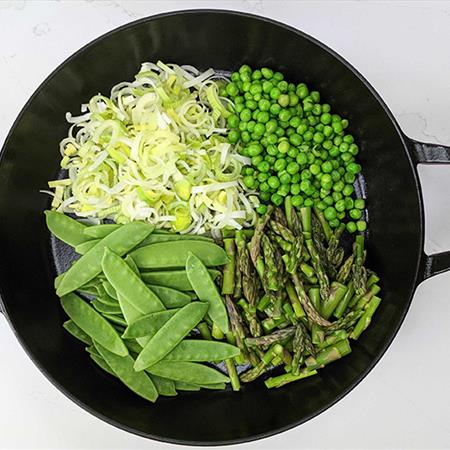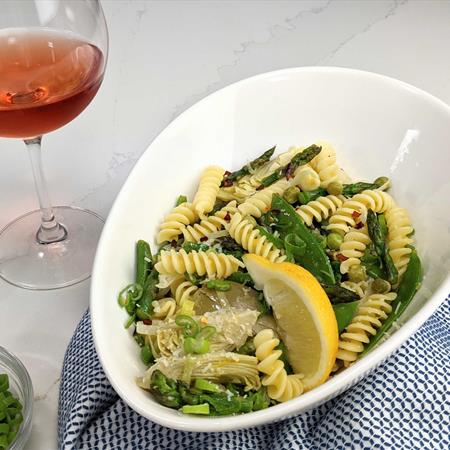Pasta Primavera: A Perfect Taste of Summer
The beauty of this Pasta Primavera recipe is that it’s simple enough to let the vegetables shine. Just some light al dente cooking and a small amount of seasoning allows you to really taste the fresh veggies. Plus, it’s full of nutritional value, too!
So, what vegetables are used in this recipe? We specifically chose veggies that are in peak season in the springtime and early summer. Let’s journey through some of the key ingredients and how to best prepare and utilize them in your cooking!

Asparagus
Peak asparagus season typically begins in late April and lasts only 4 to 6 weeks. So, be sure to utilize this distinct veg while it’s at its prime!
Asparagus varies in thickness from thin pencil asparagus to up to an inch thick at the base. No matter what size asparagus you have available to you, they all taste equally great. Just remember that thinner asparagus will cook significantly faster than thick asparagus. If you have particularly thick asparagus, you may want to start cooking that a few minutes before the other vegetables to make sure it’s properly cooked.
The bottom ends of asparagus tend to be a little woody, so we recommend trimming or snapping off the bottom inch or so of each stalk for best results.
If you have extra asparagus, the best way to store it is upright in a glass with a little bit of water at the bottom, refrigerated. It helps to trim the ends before standing the asparagus in the water so that they absorb more water and stay crisp and firm in the refrigerator.
Shell Peas & Fava Beans
Fresh peas are hard to come by most of the year, but you can find them popping up in farmer’s markets in the spring. They’re sold in pods, so you’ll have to shuck them. Don’t be intimidated though. You just have to tear the stem backwards to separate the pod and the peas will basically fall right out.
Similarly, fava beans are sold in pods. Sometimes these can be harder to remove, so it makes it easier to quickly blanch the pods in boiling water for about one minute before shucking them. The boiling water will loosen the skin just enough to separate the pods.
While fresh peas or fava beans are definitely worthwhile when you can find them, frozen peas are also a great option in a pinch and on busy weeknights.
Leeks
Leeks can usually be found all year round at grocery stores, but they are in peak season in the spring. Related to the onion family, they are milder tasting — almost like a huge scallion.
When you prepare leeks, you’ll want to trim the tough outer dark green parts. The white part and the light green part of the leek is the edible portion.
Snow Peas & Sugar Snap Peas
Like peas and fava beans, snow peas and sugar snap peas are also part of the legume family and are grown in pods. However, the pods of snow peas and sugar snap peas are actually edible.
You can eat snow peas and sugar snap peas as-is, but some people prefer to trim off the tough string that runs along the outside of the pod for a more pleasant eating experience. This is totally optional. To do this, use a paring knife to split the top of the pea and simply pull the string from end to end to remove.
Chives
Chives are also widely available, but they grow best in the spring and the fall when the weather is a bit cooler. The flavor of chives is similar to that of a green onion, but they are a bit thinner and more tender.
As an alternative, mint is another herb that works beautifully in pasta primavera. Using fresh herbs adds brightness to this dish.

Pasta Primavera: Tips for Success
Far and away our biggest tip for perfect primavera is to avoid overcooking the vegetables. You want to cook them “al dente” with a slight bite to retain all their lovely textures. Overcooked and mushy veg are a primavera DON’T.
The beauty of this recipe is that it really is quite flexible — go to your farmer’s market and use whatever is in season! You can easily swap these spring vegetables for summer tomatoes and zucchini.
Whatever veggies you use, we recommend a light hand on the seasoning, drizzling with just olive oil and lemon create a light dressing with a slight acidity to help the vegetables really shine through.






